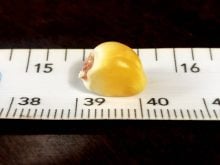Specialists from the Ontario Ministry of Agriculture, Food and Rural Affairs recently urged the province’s corn-growing livestock producers to take the issue of corn rootworm resistance to Bt traits seriously.
They said efforts in the United States to slow the growth of resistance in corn rootworm to Bt-based control traits have not been effective.
Why it matters: According to entomologist Tracey Baute, there is no new corn rootworm control measure nearing development and approval, so it’s important Ontario agriculture strives to maintain as much effectiveness as possible in the existing Bt traits.
Read Also

Packer buys Green Giant, Le Sieur veg brands from U.S. owner
A Quebec-based processor’s deal to buy the Green Giant and Le Sieur packaged and frozen vegetable brands in Canada from a U.S. owner clarifies the status of two popular retail brands grown by Canadian farmers.
“The biggest thing, and the most important thing… is to rotate out of corn,” field crop entomologist Tracey Baute told a recent OMAFRA seminar on rootworm resistance. It was subsequently acknowledged that isn’t always practical, so other strategies were offered if immediate rotation isn’t in the cards.
Forage and grazing specialist Christine O’Reilly said in the top U.S. corn-growing states, where resistance has progressed faster than north of the border, one lesson learned was that early strategies, such as refugia and careful variation of stacked or pyramid hybrids, did not involve livestock producers who grow corn. As a result, corn-on-corn rotations persisted even though all top advisers urged their end.
“While we know that livestock producers aren’t the only people growing continuous corn, we do know they have a stronger incentive to do that because they need a high-yielding, high-quality source of feed,” she said.
O’Reilly said the challenge is not necessarily crop protection in nature, but rather a feed inventory problem.
Very little matches corn for yield potential. Even though livestock producers can suffer the most significant yield losses from infestations, owing to their use of the entire plant, they need good alternatives to replace that energy source.
Fodder beets are very high yielding, O’Reilly noted, with high energy. But “the equipment might be a challenge, so (beets) might be something more long-term.”
Until then, it’s grasses. Spring cereals, though, can serve as corn rootworm hosts; winter grasses, thanks to their high-growth stage coming when the rootworms aren’t active, are the most likely. As well, spring-planted sorghum species, which use a toxin to repel corn rootworm, have potential.
(Click here to learn more about O’Reilly’s examination of the various options.)
Both O’Reilly and Baute acknowledged that rotation away from corn might not always be practical. If you can’t, though, Baute urged growers to recognize that three of the four Bt proteins serving as below-ground corn rootworm controls in today’s pyramid hybrids are closely related. So if there’s resistance to one, there’s almost certainly resistance to all three.
“We strongly discourage just switching to a different pyramid hybrid in the hopes that’s going to solve the problem because we’re past that point now.”
If you can’t rotate, she advised, use an above-ground control. This may come in the form of a high-rate neonic treatment, or in the form of an investment in insecticide boxes on your planter. Either one requires planning.
A new intake just opened for Canadian Agricultural Partnership cost-share funding, and insecticide boxes, as well as custom pesticide applications are part of this program.
Another emerging option is bio-control nematodes. Work underway in New York state suggests these can be applied one time and last up to 10 years. Baute showed a side-by-side photo from one of the New York trial plots, and asked anyone interested in trying it to contact her.
Don’t, however, look to a high-rate insecticide during the growing season. Baute offered two reasons: they mask injury so you don’t know you’ve got a problem, and they could delay adult emergence and thereby increase the number of resistant survivors at the end of the season.
From a livestock perspective, O’Reilly said the most important strategy isn’t in the field but rather in the farm office — be it a mobile office or behind a desk. She urged producers to set up a conference call with both their agronomist and nutritionist. “Please, use the time this winter to get everybody on the same call… and come up with that crop plan that meets the feed needs.”















